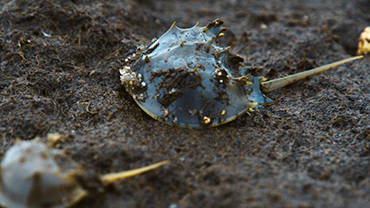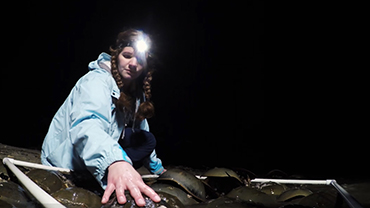Transcript
NARRATOR:
Ancestors of horseshoe crabs date back over 450 million years!
Maggie Pletta:
So the horseshoe crab is oftentimes called the dinosaur of the ocean. Because it’s been around since before the dinosaurs. The dinosaurs went extinct - this guy stayed around.
NARRATOR:
Horseshoe crabs are arthropods - that means they have an exoskeleton, a segmented body, and jointed appendages, but they don’t have a backbone.
Horseshoe crabs molt, leaving their old shells behind and growing new, larger shells.
Their main eyes are compound, like a housefly’s, but they also have five more eyes on top of their shells, and two underneath!
Maggie Pletta:
They have sensory eyes here, all along their shell and down their tail, and they can tell moonlight, sunlight. They have sensors as well, and they can tell the temperature of the water, the dissolved oxygen, all of that just from their body.
NARRATOR:
The coolest thing about horseshoe crabs, though, is their blood. It’s actually blue, and copper-based! And it’s really useful.
Maggie Pletta:
When this crab gets injured, gets a little cut on its body, bacteria can get into it from the water. So the Horseshoe crab blood actually Jell-O’s around that bacteria and stops it from getting into the Horseshoe crab body.
NARRATOR:
Because of its special properties, scientists can use horseshoe crab blood to sniff out any harmful bacteria that might be present in medicines for humans.
Maggie Pletta:
There’s this compound called Limulus Amoebocyte Lysate, otherwise known as LAL. They use the LAL to test every vaccine, needle, medical equipment, anything that goes into your body is tested with the LAL.
NARRATOR:
While scientists are working on synthetic alternatives to horseshoe crab blood, every time you get a shot, you have a horseshoe crab to thank!
 An official website of the United States government.
Here's how you know we're official.
An official website of the United States government.
Here's how you know we're official.







